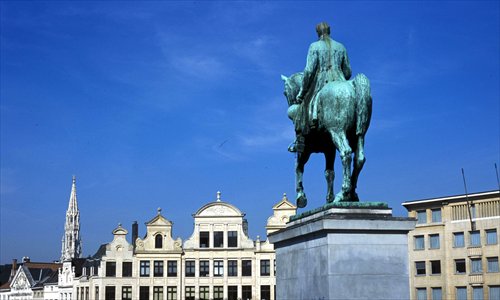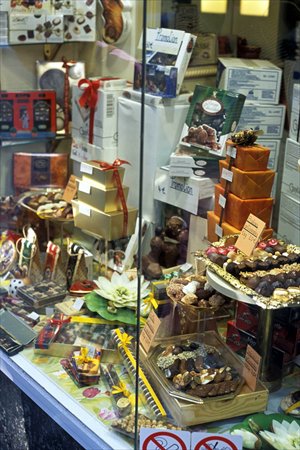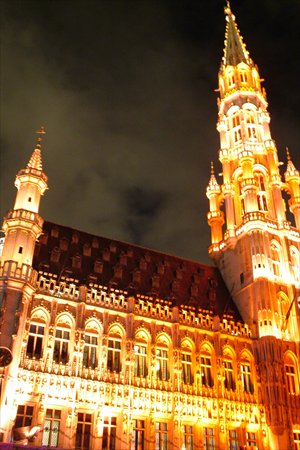‘French fries’ in Brussels
Beer, chocolate and Belgian history

A scene in Brussels Photo: CFP

A chocolate store in Brussels Photo: CFP

The night scene of Brussels Photo: CFP
When I asked my Belgian friend Jean-Marc how long I should spend in Brussels, the capital of Belgium, he answered, "forever."
I did not listen. I only spent a weekend getaway in Brussels. I thought as the home of the European Union; the city had nothing more to offer than politics. I was terribly wrong.
I have traveled to many cities in the world, but Brussels challenged all my knowledge and impressions of other cities: I thought the Swiss had the best chocolate in the world, but the Belgians told me they were the ones who invented the praline, a chocolate shell with a soft center. I thought French fries were French. No. Belgian historians claim they were the first to fry potatoes; I thought San Francisco was the gay capital of the world. I was told Brussels enjoys a high position in the "gay world" thanks to its location at the heart of the Paris/Amsterdam/Cologne "gay triangle."
So, you think you know Belgium? Think twice.
Fries: French VS Belgian
First things first, food! I was very hungry when I arrived in Brussels in the late afternoon. A local friend took me to eat. I asked what we were going to eat. "Fries," he said. "I didn't come all the way here to have French fries!" I protested. "Not French fries, Belgium fries." He corrected me.
Despite its name, French fries are not French. Belgian historians claim that it was the Belgian who first fried potatoes in the late 1600s in the southern part of the country. When the American soldiers discovered these delicious fried potatoes and wanted to introduce it during the First World War, they called it "French fries" as the official language of the Belgian army was French. To be "politically correct," I decided to stick to "Belgium fries" while eating in Belgium.
So we ordered, "Belgium fries." In China, French fries are fast food/junk food. In Brussels, it is treated as a "noble food." In many restaurants, French fries are usually served with meat; but here in Brussels, you can eat them on their own. Walking on the streets, I saw many people eating "Belgium fries" with their fingers.
The taste? I am sorry. I really could not tell the difference.
Chocolate: Swiss VS Belgian
My Belgian friend Jean-Marc asked me to bring him Belgian chocolate as a gift. "Seriously? You are living in Switzerland!"I said. He rolled his eyes at me and said, "We have the best chocolate in the world."
Alright. Switzerland and Belgium are two countries that are famous for chocolates. The Swiss are the ones who invented "milk chocolate" by adding cocoa butter to chocolate, thus making it smoother in texture; while the chocolate business in Belgium is over 100 years old. The Belgians invented the praline in 1912. The main source of its beans is from the Democratic Republic the Congo, its former African colony. Thus, it contains a much higher cocoa content, aka, dark chocolate.
It is estimated that there are about 2,000 chocolate shops in Belgium. "But we only buy the expensive small ones as a gift for boring family members, tourists and people in a hospital. Otherwise, we go to a supermarket for the big pieces," the USE-IT travel map written by the locals recommends.
So I went to a supermarket and brought myself a big piece of chocolate. I tried the 85% dark chocolate praline. Surprisingly, the taste was intense, smooth, but not bitter. I felt like it exploded in my mouth and melted in my heart. I had no idea how much chocolate I had that day, but how much chocolate is too much?
Beer battle: Belgium VS Germany
When it comes to beer, many Chinese people will think of Germany. But from a lady's point of view, I think Belgium is the beer capital. I might be a little biased because the only beer I drink is fruit beer.
According to Belgium beertourism.com, there are over 160 recognized breweries in Belgium. They produce more than 1,000 brands of beer and up to 60 percent of the production is exported to the world. The first weekend of September, Brussels hosts an annual beer festival at the UNESCO World Heritage site, Grand Place.
Apparently beer is an important part of the daily life here. In many restaurants, they recommend a suitable beer to accompany your food instead of wine. There are also special cuisines they cook with beer. I ordered Carbonnade Flamande, sweet and sour beef stew that is cooked with beer instead of red wine and, of course, it was served with "Belgium fries."
In the evening, my friend took me to one of the famous beer drinking spots, Delirium Beer Café. It is recommended in almost every tour guide book as it holds the 2004 Guinness record of having more than 2,000 brands of beer. In theory, you can go there every night and never drink the same beer for five years. In reality, the bar was a crowded, noisy and dark basement that was packed with tourists. The menu was as thick as a phone book. I barely understood anything in it. So just name your beer. I am sure they will have what you want.
Where do the local people go? Celtica. The cheapest beer bar in town. A regular beer costs only 1 euro ($1.13) before midnight!
Gay World? San Francisco VS Brussels
Brussels is a "gay-friendly" capital. It made gay marriage legal in 2003 and then gay adoption in 2005. Every year, the city hosts a gay film festival in January, and then gay pride in May.
Annual gay pride, gay film festival, and other related events have brought in a lot of money for the open-minded Belgians. Gay clubbing alone brings in about 5 million euros a year, according to visitbrussel.be.
If you are interested in gay literature and film, you can go to a gay bookshop, called Page 69. No idea if it is related to the Singaporean bookstore Page One though.
Comics: Japan VS Belgium
I thought Japan was the kingdom of comics until I met Belgium. What surprised me the most is that Belgium is the hometown of my favorite cartoon, Smurfs, small blue human-like creatures living in the forest. We called them "blue fairies."
I remember when I was little, the first thing I did when I went home after school was to turn on the TV to watch the Smurfs. But somehow I thought they were made in Japan. I did not realize I made a big mistake until I saw they were painted on comic book walls in Brussels.
Apparently, Belgians love comics. There are more than 1,000 professional comic artists among of its 10 million population. Each year, they produce more than 5,000 new comic books compared to only 500 in 1989, Willem De Graeve, the communication director of the Comics Art Museum told the BBC. In 1993, the city of Brussels started painting the comic book wall all over the center, making the capital more colorful.
Besides the Smurfs, the best-known Belgian comic character is Tintin, a young Belgian reporter. In 2011, Steven Spielberg turned it into a movie, The Adventures of Tintin.
The city of weird statues: Prague VS Brussels
When it comes to weird statues, I thought I had seen it all in Prague: from the big silver pregnant lady to the creepy giant bronze babies, to the broken men, to the young man riding on the shoulder of a headless man. I was wrong. Brussels has a lot of peeing statues.
The most famous one is the peeing boy, Manneken Pis. I went looking for it around the Grand Place. It was not easy to see because it is actually just a 24-inch tall bronze statue.
He has been peeing in public for over 400 years. There are many legends about him. The tour guide told us at least five different versions. The most epic one was when the enemy wanted to burn down the city before they left, and this little hero peed to put it out, saving the city. Another version says the little boy was transformed into a statue by a witch when he was caught peeing against her door. Fortunately, a kind old man swapped the boy with a similar statue before the witch cast her spell. Anyway, no matter what he had done, the Belgians adore him. He was stolen so many times that the government decided to swap the original with a replica. Still, people adore him so much that they made an outfit for him for every occasion, Santa suits for Christmas and national costumes from all over the world.
Maybe some people wanted to promote gender equality because they invented his sister, Jeanneke-Pis, in the 1980s and placed her in front of a restaurant. The tour guide says the owner of the restaurant just wanted to use her to attract tourists. Now the restaurant is closed, and she has stopped peeing.
There is also a peeing dog statue called Zinneke Pis. It was built in 1998 on the corner of a shopping street. No idea whether it is related to the little boy and girl, but "peeing family" does amuse tourists.
Rules of thumb
1. People eat relatively "early." Lunch finishes before 2 pm, dinner before 10 pm. Feel free to eat "Belgium fries" in between. Oh, most restaurants close on Sunday.
2. Avoid the tourist shops. Buy chocolates at supermarkets and stores. They offer a cheaper price and good quality.
3. The official language is Dutch 57%, French 42% and German 1%. Many signs in Brussels are written in both Dutch and French. Don't be surprised if people switch languages during the conversation.
4. Join a 2.5-hour walking tour and explore the city The tour starts from the Grand Place and walks you through the winding streets.